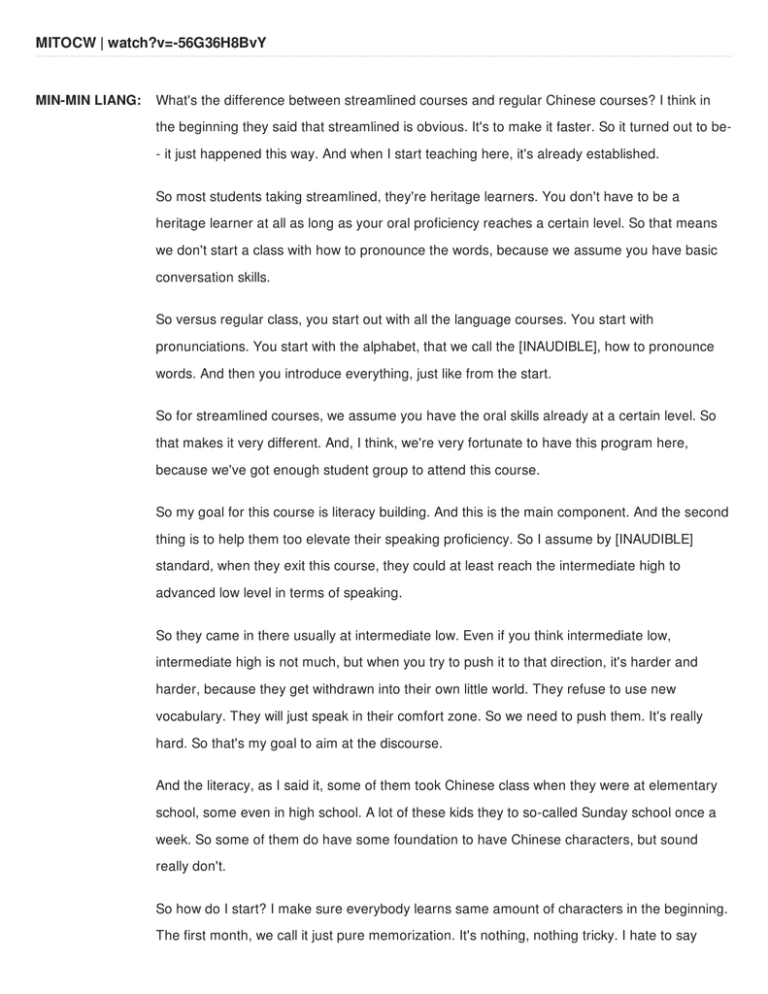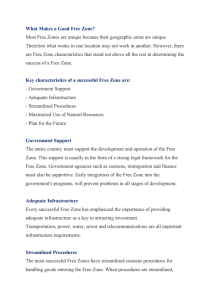MITOCW | watch?v=-56G36H8BvY
advertisement

MITOCW | watch?v=-56G36H8BvY MIN-MIN LIANG: What's the difference between streamlined courses and regular Chinese courses? I think in the beginning they said that streamlined is obvious. It's to make it faster. So it turned out to be- it just happened this way. And when I start teaching here, it's already established. So most students taking streamlined, they're heritage learners. You don't have to be a heritage learner at all as long as your oral proficiency reaches a certain level. So that means we don't start a class with how to pronounce the words, because we assume you have basic conversation skills. So versus regular class, you start out with all the language courses. You start with pronunciations. You start with the alphabet, that we call the [INAUDIBLE], how to pronounce words. And then you introduce everything, just like from the start. So for streamlined courses, we assume you have the oral skills already at a certain level. So that makes it very different. And, I think, we're very fortunate to have this program here, because we've got enough student group to attend this course. So my goal for this course is literacy building. And this is the main component. And the second thing is to help them too elevate their speaking proficiency. So I assume by [INAUDIBLE] standard, when they exit this course, they could at least reach the intermediate high to advanced low level in terms of speaking. So they came in there usually at intermediate low. Even if you think intermediate low, intermediate high is not much, but when you try to push it to that direction, it's harder and harder, because they get withdrawn into their own little world. They refuse to use new vocabulary. They will just speak in their comfort zone. So we need to push them. It's really hard. So that's my goal to aim at the discourse. And the literacy, as I said it, some of them took Chinese class when they were at elementary school, some even in high school. A lot of these kids they to so-called Sunday school once a week. So some of them do have some foundation to have Chinese characters, but sound really don't. So how do I start? I make sure everybody learns same amount of characters in the beginning. The first month, we call it just pure memorization. It's nothing, nothing tricky. I hate to say there's just the effort you need to memorize characters, because that's how you learn to read. There's no way-- other shortcut Let's put it this way. It's because Chinese characters are not spelling. It's like pictures. You have to memorize them. There are rules in there. So after four weeks, people really struggle, for those who've never done it before. Because basically, every class, I force them-- three hours a week, every class, we have quiz, dictation. So before the class, they have to memorize 50 characters at least. Well, as I said, we're unique. We're fortunate they're MIT students. They're so useful, hardworking. They complain, but they did it anyway. So after one month, everybody, at least, has 250 characters. Some do have more, because they learned this before. But those who never attend Chinese schools, now they have 250 characters. So they can read now, because they know these characters individually. They put it in a sentence. Now they can read a short paragraph. So the moment they get to read the text, they are just like so excited. I can read. So then there's the writing part. So that's very different from regular, because regular we have to focus so much on four skills together. Because for true beginners, if you ask them to memorize characters, at same time how to pronounce and speak is just too much. So for heritage learners, for the streamlined class, we can do it all together. So that's a huge difference. And, as I say, we're unique. We're able to do that. And I don't think my model is good for every university, every high school, because it all depends on your audience, your student group. I have teachers from different universities that they can't have just heritage learners or streamlined classes. They have to mix them up, which just makes the teaching very difficult, because some are here, some are here. How do you make the balance? So I said, I'm fortunate. You know, I can't really give advice for those teacher who are in the middle, because this is totally different environment.



